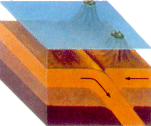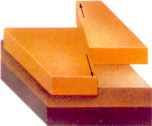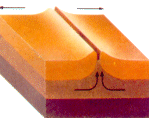
About Boundries
Trench Boundary

The present explanation for the comparative youth of the ocean floors is that where an ocean and a continent meet the ocean plate dips under the less dense continental plate at an angle of approximately 45°. All previous crust is then ingested by downward convection currents. In the Japanese trench this occurs at a rate of about 120 mm a year.
Transform Fault

The recent identification of the transform, or traverse, fault proved to be one of the crucial preliminaries to the investigation of plate tectonics. They occur when two plates slip alongside each other without parting or approaching to any great extent. They complete the outline of the plates delineated by the ridges and trenches and demonstrate large scale movements of parts of the Earth's surface.
Ridge Boundary

Ocean rises or crests are basically made up from basaltic lavas for although no gap can exist between plates, one plate can ease itself away from another. In that case hot, molten rock instantly rises from below to fill in the incipient rift and forms a ridge. These ridges trace a line almost exactly through the centre of the major oceans.


© Copyright 2002, 2003 Seelendran Naidoo
All rights reserved.
|